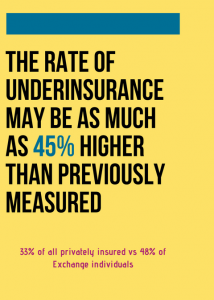Our research on the challenges and implications of health care under the Affordable Care Act helps to better determine what the under-count is and understand the factors associated with the high rates of underinsured individuals. This abstract was written and presented by Mark Noyes at the 2017 AAPOR Conference.
Abstract:
The Affordable Care Act (ACA) has provided health insurance coverage to millions and has reduced the rate of uninsurance in the U.S. from 17.6% in 2013 to 9.9% in 2016. The Act included provisions to reduce the total cost of health care, including minimum essential coverage standards, subsidies for lower income families, and out-of-pocket cost limits. Despite these efforts, a growing number are underinsured because of high deductible plans, high out of pocket medical costs, and increasing premiums. Other structural barriers limit access to care. The Commonwealth Fund found 23% of 19-to-64-year-old adults were underinsured in 2014, nearly double that of 2003. Because of the timing of fielding, the survey was not able to measure the impact of the ACA on underinsurance.
To understand the impact of the ACA on underinsurance and access to care, we conducted large, population based surveys in three states before and after implementation of the Act. Post-ACA, uninsurance rates declined to 4.2% in Rhode Island (2016) and 3.7% in Vermont (2014), but remained steady in South Dakota (8.0%; 2015). Individuals underinsured because of deductibles or out-of-pocket expenses increased significantly over this time. Underinsurance rates did not change among adults with employer-sponsored insurance, but health plans purchased through health insurance marketplaces had underinsurance rates significantly higher than those with employer based plans. We also examine the methodology by which underinsurance rates are calculated to determine whether cost and structural barriers to care should also be considered as metrics for the underinsured.
[activecampaign form=2]

